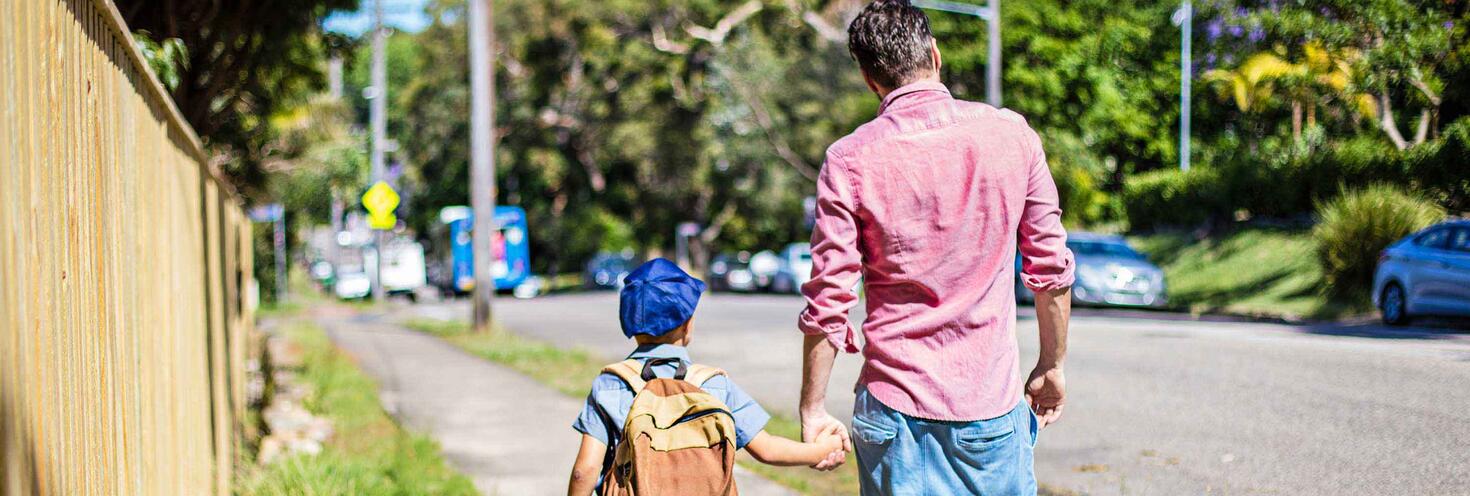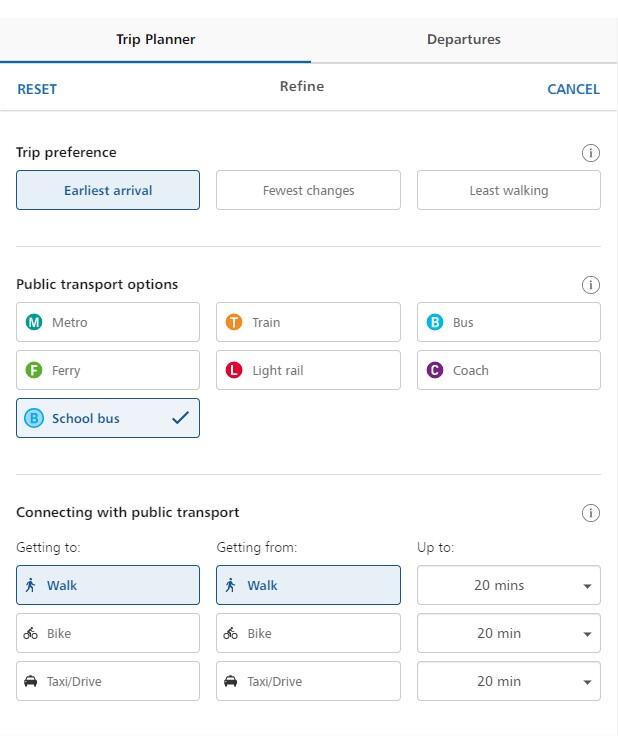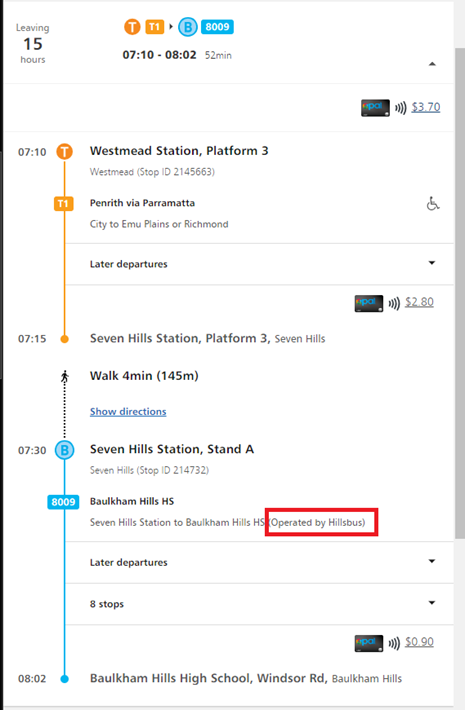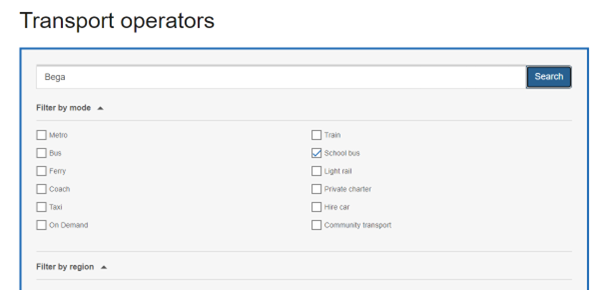Plan your trip to school

Everything you need to know about planning your trip to school and travelling to school safely.
This page is about travelling to school safely and planning your school trip for school students in NSW. If you want to apply for free or subsidised travel between school and home, go to the School Student Transport Scheme (SSTS) page.
Plan your school trip
We have tools to help you plan your school trip:
- Use the Trip Planner to find school bus routes from A to B or see your trip options on any mode
Tip: Make sure to use the Refine option and select School Bus as your Transport Mode to see school bus services - How to use the Trip Planner - You can also use the Trip Planner in the Opal Travel app
Keep updated
- Opal Travel app
- Subscribe to travel notifications - How to setup a Opal Travel app travel notifications
- Departures widget - How to setup departures on Opal Travel app
- This website
- Departures, see all the next services departing from a stop - How to use Departures
- Travel alerts, look up and favourite services to see if there are any current disruptions - How to use Travel alerts
Other tools
- Routes and timetables to see your school bus route and timetable. How to use Routes and timetables
- Transport apps to view the location of your school bus in real time using a mobile app
- You can also contact your local school bus operator for more information about the school service
- Read our other guides for more information on how to use these tools
Use the Trip Planner to plan your school travel in advance to confirm your school bus route number and stop location.
Not all schools have dedicated school bus services. Use the Trip Planner, you can see your trip options on any mode except regional buses.
If you live in Sydney and surrounds, as well as Armidale, Bathurst, Bega, Coffs Harbour or Dubbo you can plan your school bus trip with real time information.
To plan your trip to school on a school bus using the Trip Planner:
- Enter your location in the 'From' field, such as your home address
- Enter your destination in the ‘To’ field, such as your school name
- Set the date and time you wish to travel, e.g. 8.00am
- Select ‘School bus’ under the ‘Options’ tab to see school buses.
- To narrow down your results to only school buses, untick the checkboxes for the other transport modes.
- Look for the school bus icon in your trip plan results.

To identify any bus operators, once you have confirmed the best journey/s to school using the Trip Planner, expand the section/s of the trip plan. Look for the ‘Operated by’ note on the page.

Need additional help with planning? Visit our Help page.
Find your local transport operator using the search tool by filtering by school bus and region and contact them directly for trip planning help. Schools may also provide assistance and information.

The following bus operators are available in Greater and Outer Metro Sydney.
| Operator | Operator Name in School Student Transport Scheme and Term Bus Pass Applications |
| Blue Mountains Transit | Blue Mountains Transit Pty Ltd |
| Busways Central Coast | Busways Central Coast |
| Busways North West | Busways North West Pty Ltd (Sydney) |
| Busways R1 (Sydney Western Suburbs) |
Busways R1 Pty Ltd |
| CDC NSW R4 (Hills District) |
CDC NSW R4 Pty Ltd |
| CDC NSW R14 (Forest District, North Shore) |
CDC Forest District |
| Coastal Liner | Coastal Liner |
| Dion's Bus Service | Dions Bus Service |
| Hunter Valley Buses | Hunter Valley Buses |
| Keolis Downer Northern Beaches | Keolis Downer Northern Beaches |
| Newcastle Transport | Newcastle Transport |
| Port Stephens Coaches | Port Stephens Coaches |
| Premier Charters | Premier Charters |
| Premier Illawarra | Premier Illawarra |
| Redbus CDC NSW | Redbus CDC NSW Pty Ltd |
| Rover Coaches | Rover Coaches |
| Transdev John Holland Buses | Transdev John Holland Buses (NSW) Pty Ltd |
| Transit Systems (Inner West Sydney, Inner South Sydney) |
Transit Systems West Pty Ltd |
| Transit Systems (South West Sydney, Sydney Western Suburbs) |
Transit Systems NSW |
| Transit Systems NSW SW (South West Sydney) |
Transit Systems South West |
| U Go Mobility | U Go Mobility South West |
If you're applying for Newcastle Transport, once approved you'll be able to use Newcastle Light Rail, Newcastle Buses and the Stockton Ferry. You won't need to select those operators individually.
Conduct while travelling
When travelling to and from school on public transport students are expected to be courteous and responsible and follow the Transport for NSW Guidelines for Managing School Student Behaviour on Buses (pdf 727KB) and the School Student's Code of Conduct for travel.
Bus travel advice for parents and carers
Parents and carers play a key role in their children's safety when travelling on public transport to and from school.
Bus safety for school students (pdf 377KB) has more information on how families can help keep children safe getting on and off buses.
The Safety Town website has activities you can do with primary school children to help them keep safe on and around buses. There is also a section for families on driving safely around buses, and getting children to and from the bus stop safely.
- Families are responsible for getting their child to and from the bus stop safely.
- Always supervise your child until they are at least 10 and hold their hand when walking to and from the bus stop or interchange and when crossing the road.
- When waiting for the bus, hold hands and wait as far back from the passing traffic as possible.
When travelling by bus, your child is most at risk in the minutes after they get off the bus.
Meet your child AT the bus stop or interchange after school. NEVER wait on the opposite side of the road and call them across. If you cannot meet your child, organise for a trusted adult to take your place.
Always wait until the bus has gone, then use a safe place to cross.
Talk with your child about what to do:
- if you are delayed and cannot meet them as usual
- if they catch the wrong bus
- if they get off the bus at the wrong bus stop.
Crossing the road together, choose the safest place to cross the road and talk about:
- STOP! one step back from the kerb
- LOOK! continuously both ways
- LISTEN! for the sounds of approaching traffic
- THINK! whether it is safe to cross
Keep checking as you cross the road.
Bus lights flash on the front and back of a bus when the bus is picking up or setting down school children.
A 40km/h speed limit applies when bus lights flash. The speed limit is for all traffic travelling in the same direction as the bus, whether the bus is stationary or moving.
Informal bus stops are not sign posted and are usually found in rural areas. They may be at the front of a property or on the side of the road.
Drivers may find it difficult to see children at informal bus stops. Families should take special care when using these stops. Staying on the bus a bit longer to travel to another bus stop may reduce the need for your child to have to cross the road.
For more information on selecting or reviewing informal bus stops visit the Centre for Road Safety website.
Travel outside of school
When using public transport other than for school, children aged 4 to 15 years are entitled to concession travel. Secondary students aged 16 years and over also pay concession fares with their proof of entitlement card. Find out more.